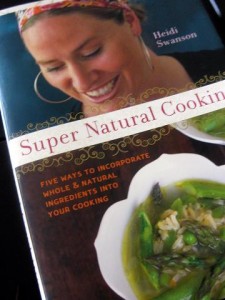 It was fitting to celebrate our one year anniversary Cookbook Club with a local San Franciscan author. Heidi Swanson’s Super Natural Cooking does more than encourage her readers to “buy local.” She focuses on simplistic cooking using whole and natural ingredients. Most importantly, it reaches out to the everyday home cook with its warm and alluring photos and delicious recipes that easily come together.
It was fitting to celebrate our one year anniversary Cookbook Club with a local San Franciscan author. Heidi Swanson’s Super Natural Cooking does more than encourage her readers to “buy local.” She focuses on simplistic cooking using whole and natural ingredients. Most importantly, it reaches out to the everyday home cook with its warm and alluring photos and delicious recipes that easily come together.
For this month’s cookbook club, we prepared dishes to sample each chapter of Heidi’s cookbook.
Chapter 1 | Build a Natural Foods Pantry
Heidi explains the first step in natural cooking is to expand your pantry with whole and natural flours, oils and fats, sweeteners, spices, and seasonings. For most cookbook club participants, we found needed ingredients at Rainbow Grocery, Whole Foods, and Trader Joe’s if we didn’t already have the items in our pantry.
Chapter 2 | Explore a Wide Range of Grains
Savory Amaranth Souffle
A gruyere soufflé baked in ramekins lined with toasted amaranth seeds. Just from the first bite, the abundant flow of creamy nuttiness caused everyone to ask what type of cheese was used for the soufflé. Though simple in appearance, the toasted amaranth seeds framed the soufflé well and complemented the soft texture with a grainy crunch. Bibby had mixed feelings about the soufflé texture and felt it would be a great breakfast dish given its texture noticeably similar to grits. Bibby admitted she didn’t make this recipe completely “natural” because she used white flour instead of amaranth flour, which may have given the soufflé its lighter texture.
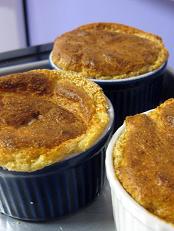
Otsu
Japanese buckwheat noodles tossed in toasted ginger-sesame dressing with pan-seared tofu, sliced cucumbers, and green onions. This was applauded as a light, refreshing Asian alternative to pasta salad. Sandra marinated the tofu in the ginger-sesame dressing before pan-searing it to create a robust and flavorful browning. She learned “shoyu” sauce called for in the dressing is the Japanese word for “soy” sauce.
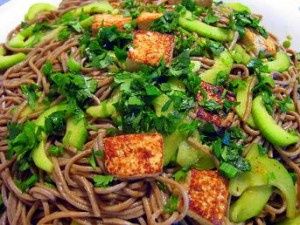
Chapter 3 | Cook by Color
Clemenquat Salad with Walnuts and Parmesan Shavings
This gorgeous salad of clementines, kumquats, celery, and walnut halves clearly demonstrates Heidi’s philosophy of cooking with colorful foods full of phytonutrients. Tanya was surprised by the salad’s beautiful colors and visual appeal because it was comprised of only a few simple ingredients. It was, however, a labor intensive salad to remove the skin and membrane from the clementines and celery. Sweet, crunchy, and slightly salty, this bright salad would be the envy at any buffet.
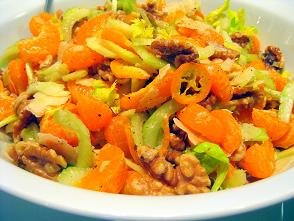
Sweet Potato Spoon Bread
Baked and mashed sweet potato casserole dotted with goat cheese and topped with parmesan cheese. This recipe appealed to Lauren with the possibility of being a “heartier” whole foods dish, and she was pleased with the ease of making this sweet potato casserole. She used red onions instead of shallots called for in the recipe, and it still paired nicely with the goat and parmesan cheeses. Resembling a sweet potato soufflé, this would be a great side dish for Thanksgiving.
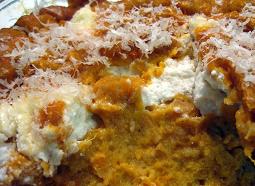
Chapter 4 | Know Your Superfoods
Beluga Lentil Crostini with Chevre-Chive Spread
Goat cheese spread topped with beluga lentils on crostini toast. Erin learned beluga lentil turns shiny when it gets wet, and more than one of us had to look closely to realize it wasn’t caviar! As Heidi instructed, Erin used a splash of milk to help the goat cheese spread easier. The chive blossoms purchased at Rainbow Grocery were used as garnish atop these appetizer masterpieces.
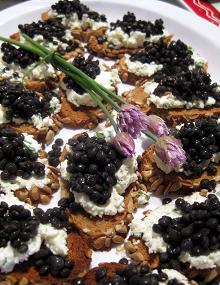
Lime-Bathed Peanut Salad
Tomatoes and raw peanuts dressed with lime juice, olive oil, salt, jalapeno chile, and cilantro. Truly simple and easy to make. Bibby compared this salty, cool mixture to salads that can be found at many Burmese restaurants.
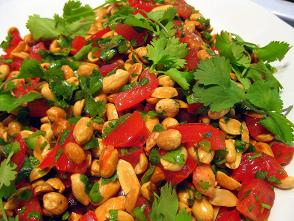
Hijiki and Edamame Salad
Dried hijiki, edamame, daikon, carrot, baby spinach, and soybeans in creamy miso dressing. Using a new ingredient, Rossie discovered dried hijiki at Rainbow Grocery costs $117 a pound! She only needed 2 tablespoons which (thankfully) expanded to an entire bowl. Rosie found this dish easy to prepare and would use the dressing for other salads because she enjoyed it so much. Edamame and canned soybeans were listed as separate ingredients, reminding us that edamame is a type of green soybean.
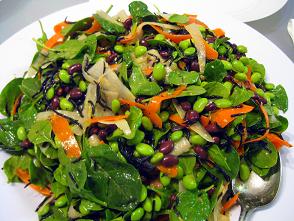
Garlic Scape Soup
Pureed soup with potatoes, spinach, garlic scapes, and lemon. This soup was akin to vichyssoise soup which also uses garlic, potato and stock. A helpful side tip from the recipe says green onions can be substituted for the seasonal scapes. Crissy thought of using spring (or green) garlic for even more flavor. Crissy used only 2 of the 3 potatoes in the recipe which she felt was still plenty of starch. The baby spinach gave the soup a more vibrant green color. We also tried the soup cold the next day, and agree with Heidi that it tastes even better the day after!
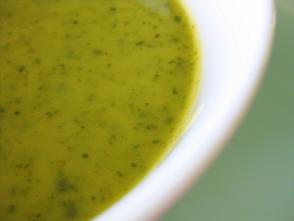
Chapter 5 | Use Natural Sweeteners
Red Quinoa – Walnut Cookies
Cookies made from whole wheat pastry flour, butter, natural cane sugar, eggs, rolled oats, red quinoa, and toasted walnuts. It was Erin’s first time using unrefined cane sugar and she appreciated the opportunity to purchase it in the bulk bins at Whole Foods. She whipped the butter for a long time using a stand mixer. This may have created a runny batter and Erin had to add more flour to the mixture after the first batch spread together. Needless to say, the innovative use of quinoa in cookies helped meet our daily dose of healthy grains (ignore the fact these cookies aren’t guilt free)! Next time, Erin will consider using mini muffin tins to possibly give better shape for these addictive biscuit-like cookies.

Basic Chocolate Cake
Michele branched away from the cookbook to try a recipe from Heidi’s website: www.101cookbooks.com. Sweetened only by maple syrup and coconut milk, Michelene was definitely skeptical to try a cake sans sugar. Perhaps it was a self-fulfilling prophecy, but this recipe was the least favored dish. Heidi described this as a “chocolate-packed, moist” cake, yet we found it dense and dry. Michelene noted the batter was thick and almost dough-like before she baked it in the pyrex dish. However, the maple sweetened chocolate-whipped cream frosting did manage to receive some approvals from the table.
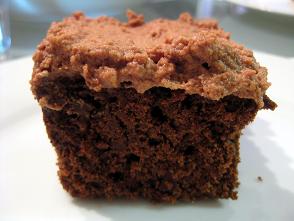
Keep joining us as we cook Fat by Jennifer McLagan in next month’s Cookbook Club at Parties That Cook!
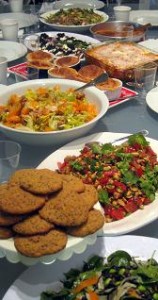
Contributed by guest blogger Sandra Vu


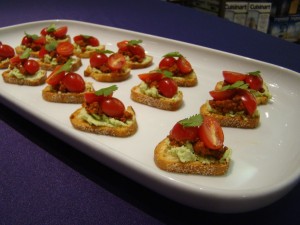
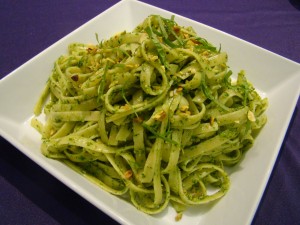
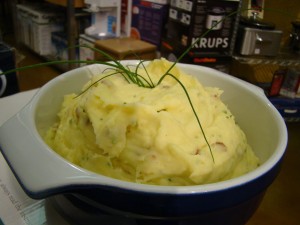

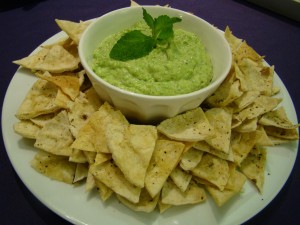

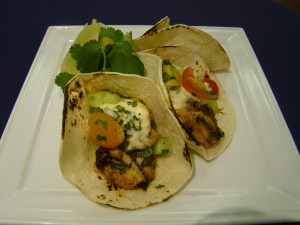
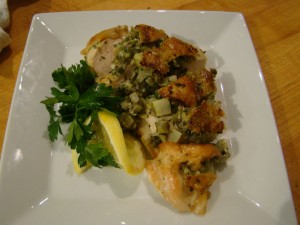
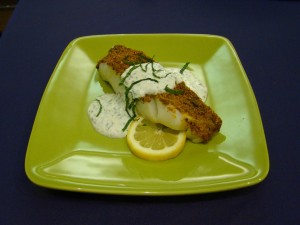
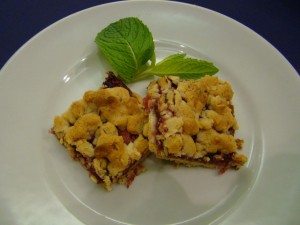












; ?>/img/parties-that-cook-blog-logo.jpg)

